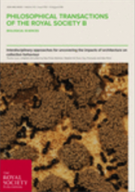Accueil > Centres de ressources > Espaces de travail > Documentation > The architecture of network collective intelligence
The architecture of network collective intelligence
Philosophical transactions of the royal society B : biological sciences, août 2018
Volume 373, Issue 1753
This study examines the correlations between the network collective intelligence, spatial layout, and prestige or status outcomes at the individual and team levels in an organization. The author proposes that spatially influenced social cognition shapes which individuals become members of prestigious teams in organizations, and the prestige perception of teams by others in the organization.
Abstract :
A social network represents interactions and knowledge that transcend the intelligence of any of its individual members. In this study, I examine the correlations between this network collective intelligence, spatial layout, and prestige or status outcomes at the individual and team levels in an organization. I propose that spatially influenced social cognition shapes which individuals become members of prestigious teams in organizations, and the prestige perception of teams by others in the organization. Prestige is a pathway to social rank, influence and upward mobility for individuals in organizations. For groups, perceived prestige of work teams is related to how team members identify with the group and with their collaborative behaviours. Prestige enhances a team’s survivability and its access to resources. At the individual level, I ran two-stage Heckman sample selection models to examine the correlation between social network position and the number of prestigious projects a person is a member of, contingent on the association between physical space and social ties and networks. At the team level, I used linear regressions to examine the relationship among network structure, spatial proximity and the perceived prestige or innovativeness of a project team. In line with my hypotheses, for individuals there is a significant correlation between physical space and social networks, and contingent on that, between social network positions and the number of prestigious projects that a person is a member of. Also in accordance with my hypotheses, for teams there is a significant correlation between network structure and spatial proximity, and perceived prestige. While cross-sectional, the study findings illustrate the importance of considering the spatial domain in examinations of how network collective intelligence is related to organizational outcomes at the individual and team levels.
Voir en ligne : L’article intégeral

